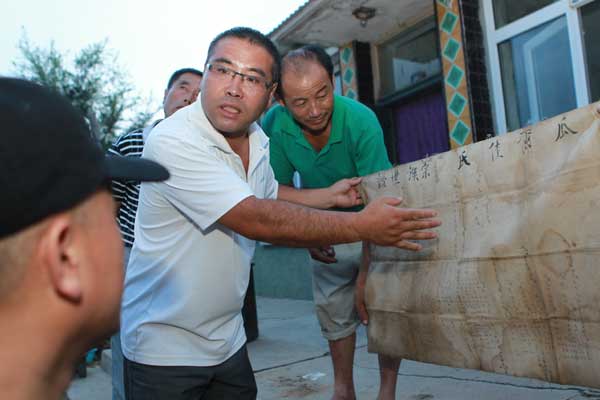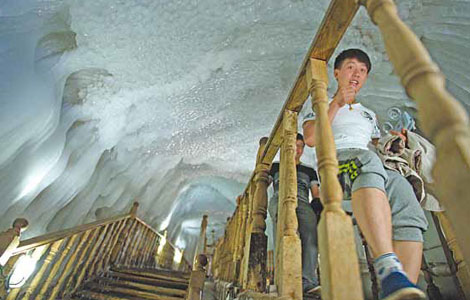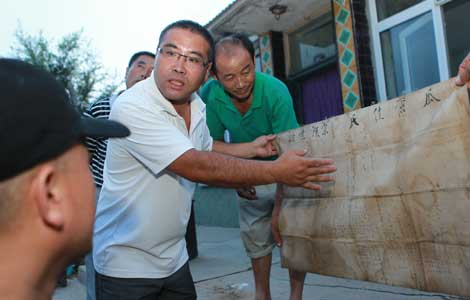Xibe group re-enacts their ancestors' journey to the west
Updated: 2013-08-15 01:52
By Cui Jia in Shenyang (China Daily)
|
||||||||
As their ancestors did 249 years ago, eight Xibe people knelt before a memorial tablet at a family temple in Shenyang, Liaoning province, on Wednesday in preparation for a long journey west to Xinjiang.
The route will not be as arduous as centuries past, but it will take them from Shenyang to Xinjiang via Mongolia.
 |
|
Guan Dazhi, of the Xibe ethnic group in Laohutou village in Kaiyuan, Liaoning province, shows his family tree on Tuesday. Some villagers embarked on a journey to pay tribute to their ancestors. [Cui Meng / China Daily] |
Four among the group were born in the Qapqal Xibe autonomous county in northern Xinjiang, the only Xibe autonomous county in China. Each of the four said they are desperate to discover more about their roots.
The other four Xibe people are from Kaiyuan, Liaoning province, and are going on the journey to find out how people live in Xinjiang.
In 1764, more than 1,000 Xibe soldiers trained in archery were dispatched to Xinjiang from Northwest China by Emperor Qianlong of the Qing Dynasty (1644-1911) to guard the nation's borders.
The soldiers' family members — about 3,000 of them — accompanied them to form a massive caravan.
After 16 months on horseback, the Xibe caravan arrived at Qapqal in the Ili Kazak autonomous prefecture, where they found the living conditions extremely harsh.
But they soon adapted to the environment and built relationships with other ethnic groups in the region, such as the Kazaks and Uygurs, by teaching them how to farm. After years of guarding the region, the Xibe clan decided to relocate to Qapqal permanently.
Today, the number of Xibe people in Xinjiang is only about 20,000, making up only 12 percent of the Xibe population in China. Still, they have preserved their culture and language because they are relatively isolated.
The same cannot be said for some of the Xibe travelers. They admitted that they could barely speak and write the language.
Zha Jinghai, 46 and one of the four born in Qapqal, was emotional during the ceremony at the family temple.
"My ancestors left home here and never came back. Following the exact route of migration is not only about traveling but to reconnect history. My ancestors' blood or sweat might just be on the stones along the road."
On Tuesday, Zha visited Laohutou, near Kaiyuan, a village that sent many people to Xinjiang during the Qing Dynasty.
"My family might have come from this village. The landscape of the farmland and the decoration in the house immediately brings me back to Qapqal. It's the first time I have come to this village, but everything just feels so familiar."
Guan Dazhi, a Xibe villager in Laohutou, said Zha is his brother regardless of whether they are blood relatives. Two of Guan's ancestors were sent to Xinjiang during the Qing Dynasty. "I feel ashamed not being able to speak the language. Unlike Zha, we have no idea how to shoot an arrow, but we keep the drinking tradition," Guan said.
Laohutou has 1,816 villagers and 1,642 of them are of the Xibe ethnic group. The village customs are highly influenced by Han culture and little of the Xibe tradition has been kept.
To revive the Xibe traditions, the village hired Xiao Chang, a Xibe expert from Xinjiang, to teach the Xibe language at the local primary school.
"My grandfather told me that my family migrated from Laohutou, so I will teach the children everything I know about Xibe," the 60-year-old expert said. "But it's really difficult for them to master the language and culture when no one around them understands it."

 Two killed in fiery crash of UPS cargo jet
Two killed in fiery crash of UPS cargo jet
 Special bus seat for breast-feeding mothers
Special bus seat for breast-feeding mothers
 Northern exposure
Northern exposure
 Re-enacting ancestors' journey to the west
Re-enacting ancestors' journey to the west
 Yao dreams of sports for fun with towering charity
Yao dreams of sports for fun with towering charity
 Protests arise in Taiwan over 'comfort women'
Protests arise in Taiwan over 'comfort women'
 Huawei unveil Ascend P6 smartphone in Vienna
Huawei unveil Ascend P6 smartphone in Vienna
 When small is beautiful in hotel industry
When small is beautiful in hotel industry
Most Viewed
Editor's Picks

|

|

|

|

|

|
Today's Top News
Abe rules out visit to Yasukuni shrine
Snowden case not to affect US-Russia talks
Over 200 dead after Egypt forces crush protesters
Manning 'sorry' for US secrets breach
China to probe foreign automakers
2 killed in crash of UPS cargo jet
Watchdog to protect rights of consumers
Sizzling summer tops the record list
US Weekly

|

|





